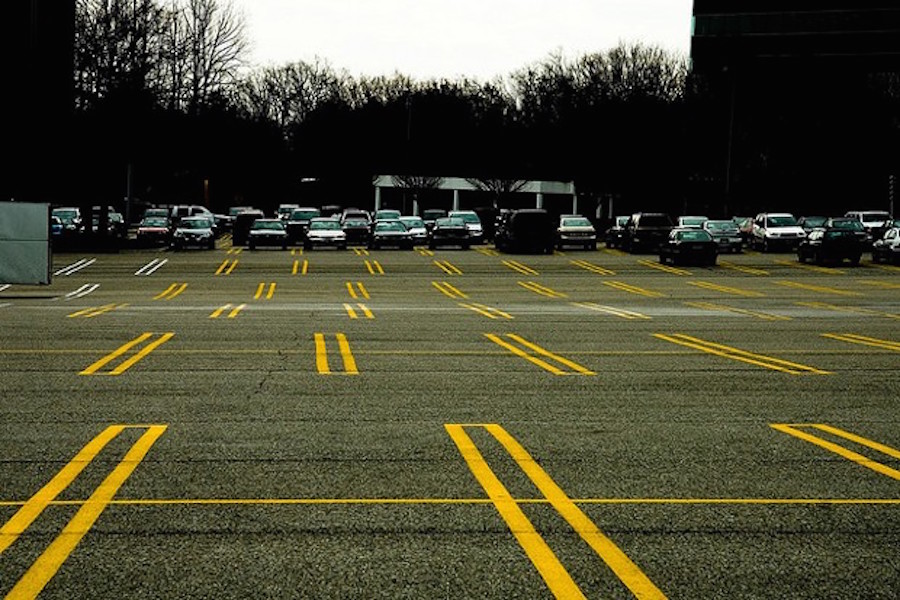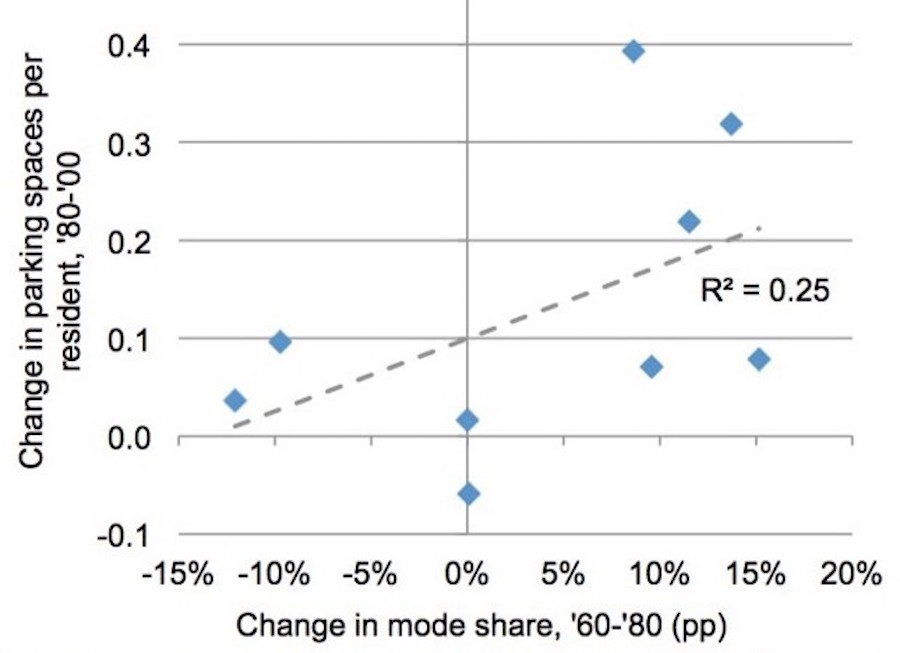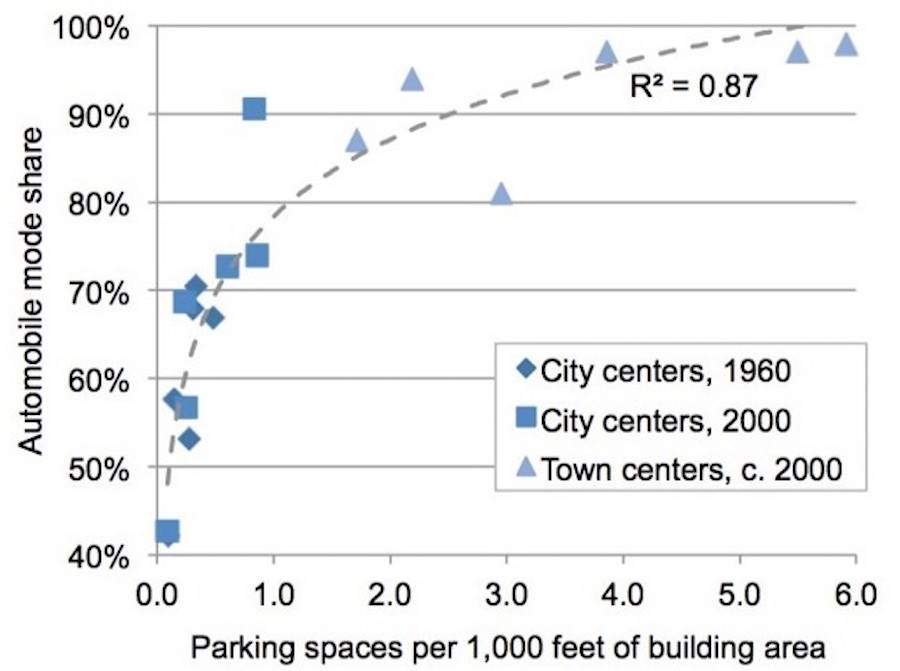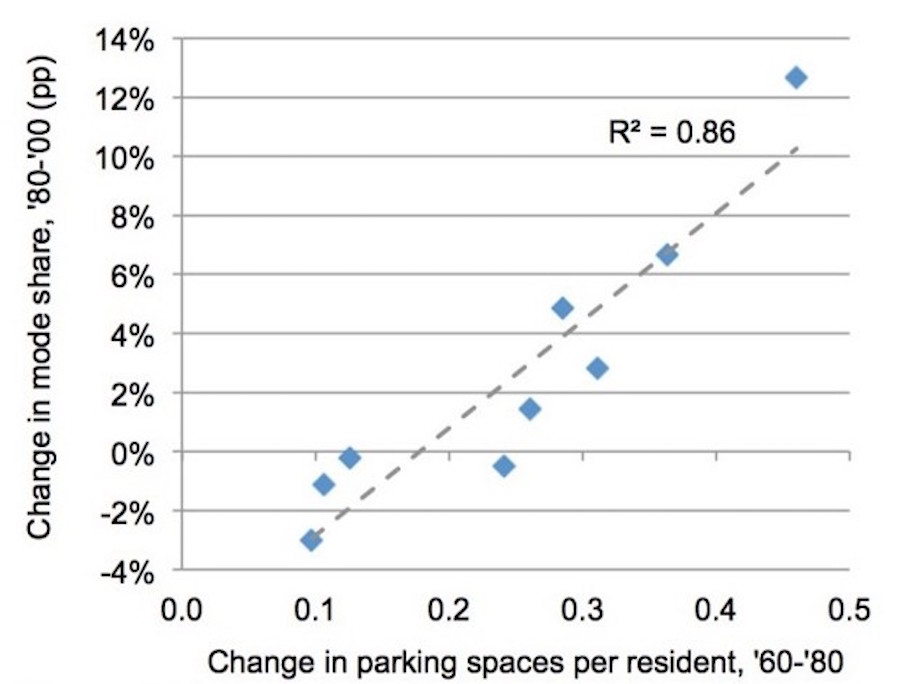Long after it was painfully clear that cigarettes caused cancer, big tobacco companies maintained that no such link existed, on the grounds that it’s incredibly hard for scientists to prove causation. The “no causality” stance appeared in 89 percent of lawsuits before 1997, according to one review. That fell to just 25 percent in 2003, but even then you could find an R.J. Reynolds chemist testifying that “the rigorous scientific proof of causation is not complete.”

In the urban planning world, a parallel to the smoking-cancer connection is the tie between parking and driving. Cheap, excessive parking has been linked to more drive-alone commutes, worse traffic congestion, higher rents, and all the other social costs of over-reliance on cars for urban mobility. But the fact that so many U.S. cities cling to minimum parking policies suggests that officials don’t see parking as a key cause of increased driving—instead, perhaps, just a natural response to it.
The case for causality gets stronger in a new analysis set to be presented at a conference this week. Chris McCahill of the State Smart Transportation Initiative and a trio of University of Connecticut scholars offer “compelling evidence that parking provision is a cause of citywide automobile use.” They do so by taking a page from epidemiology—adopting a framework meant for “inferring causality” in the face of a statistical association known as the Bradford Hill criteria.
Strength of the association
A main metric within the Hill criteria is strength of the association. Courts, for instance, have in the past accepted that a relative risk of 2.0 is sufficient to show that a particular agent (such as cigarettes) caused a disease (such as lung cancer).
From our partners:
In drawing their own association, McCahill and company used historical aerial photos and modern GIS inspection to estimate the area devoted to parking in nine midsized U.S. cities during three eras: circa 1960, 1980, and 2000. None of these metros had seen big population growth over this period, suggesting their built environment was already mature by the mid-20th century. Some had high car-reliance (as measured by census data on driving to work), such as Hartford; some didn’t, such as Berkeley.
Yet the connection between parking and driving was a “consequential” one. The researchers found that as a city went from 0.2 parking spaces per person to 0.5 per person, the share of car commuting went from 60 to 83 percent—good for a relative risk of 1.4. That association isn’t quite as strong as a court-approved health link, but it’s still “quite substantial.”

Consistency and specificity
The Bradford Hill criteria also include consistency across time and place. Just as you get lung cancer smoking in Anchorage and Albuquerque alike, plenty of studies have shown a solid correlation between parking and driving supply in cities across the U.S. and around the world. The inferred causality also gets stronger if there’s a specific case where the problem occurs in a population without another likely reason.
Here McCahill’s team points to the work of parking whiz Rachel Weinberger, now at consulting firm Nelson\Nygaard, who has compared commute habits in New York City neighborhoods. One study found that though variables like transit time, income, and car-ownership suggested Park Slope, Brooklyn, should have more car commuters than Jackson Heights, Queens, residents in the latter area were actually 45 percent more likely to drive to work into Manhattan and 28 percent more likely to drive to work overall.
There was one specific likely reason for the gap: Jackson Heights has many times more parking spots available than Park Slope.
Sequence of events
If cigarettes cause cancer, then the sequence of a person first smoking and later developing the disease should hold fixed. On the contrary, the mere presence of lung cancer should not be as powerful a predictor of whether a person smokes, since the illness can have several causes. (The latter could still have some explanatory power, since a person diagnosed with lung cancer might start smoking, since why not.)
Indeed, McCahill’s group found that order mattered in their own analysis: parking changes predicted driving changes more powerfully than the reverse chain of events. Changes in parking availability per resident between 1960 and 1980 had a very steep correlation with later car use (top). Meanwhile changes in commuting over that period had a far weaker link with subsequent parking shifts (bottom).

Dose-response
Another element of epidemiological show of causality is a dose-response: the more you smoke, for instance, the more likely overall that you develop cancer. Pulling data from previous research of town and city centers, McCahill et al “validate this concept.” They show that as parking spots per building area increased in a place, the mode share for driving also increased, even approaching 100 percent.

Controlled experiment
Ideally a causal link would have a controlled trial supporting it. The best the parking researchers can offer here is a quasi-experimental case of Hartford. In that car-oriented metro, they write, most of the big companies give workers free parking, with drive-alone commute shares ranging from 83 to 95 percent. When one major employer began charging for spots, however, it found that 71 percent of employees drove to work—hardly a small share, but relatively less than the city average.
Plausibility
Not least among the Bradford Hill criteria is a plausible biological mechanism for why one factor might cause an illness.
“In the case of parking, cost and convenience provide very reasonable explanations for increased driving.”
When it’s cheap and easy to find a spot near a destination, taking a car becomes a very attractive option; when parking is expensive (say, via congestion or market pricing) and scarce (say, by removing developer parking minimums), alternative modes start to appear more time- and cost-efficient.
There’s also a parallel in the transport planning world with the concept of induced demand, which holds that the more space there is on the road, the more people drive.
“It seems likewise reasonable that the more spaces there are to park, the more people would drive to reach them.”
A “likely” cause
So there’s the case. As McCahill et al admit, the parking-driving association doesn’t meet every criteria within the epidemiological framework perfectly. But they feel confident enough to conclude that “parking provision in cities is a likely cause of increased driving among residents and employees in those places.” Evidence for a reverse link, suggesting that cities merely supply a parking demand that already exists, just doesn’t seem as firm.
As a result, they suggest that cities consider policies designed to limit parking to its strictest natural demand. These include the elimination of minimum parking requirements, the use of maximum parking requirements in some places, and the implementation of market-based pricing. What’s at stake, they conclude, is nothing less than the health of the city.
This feature originally appeared in CityLab.

















